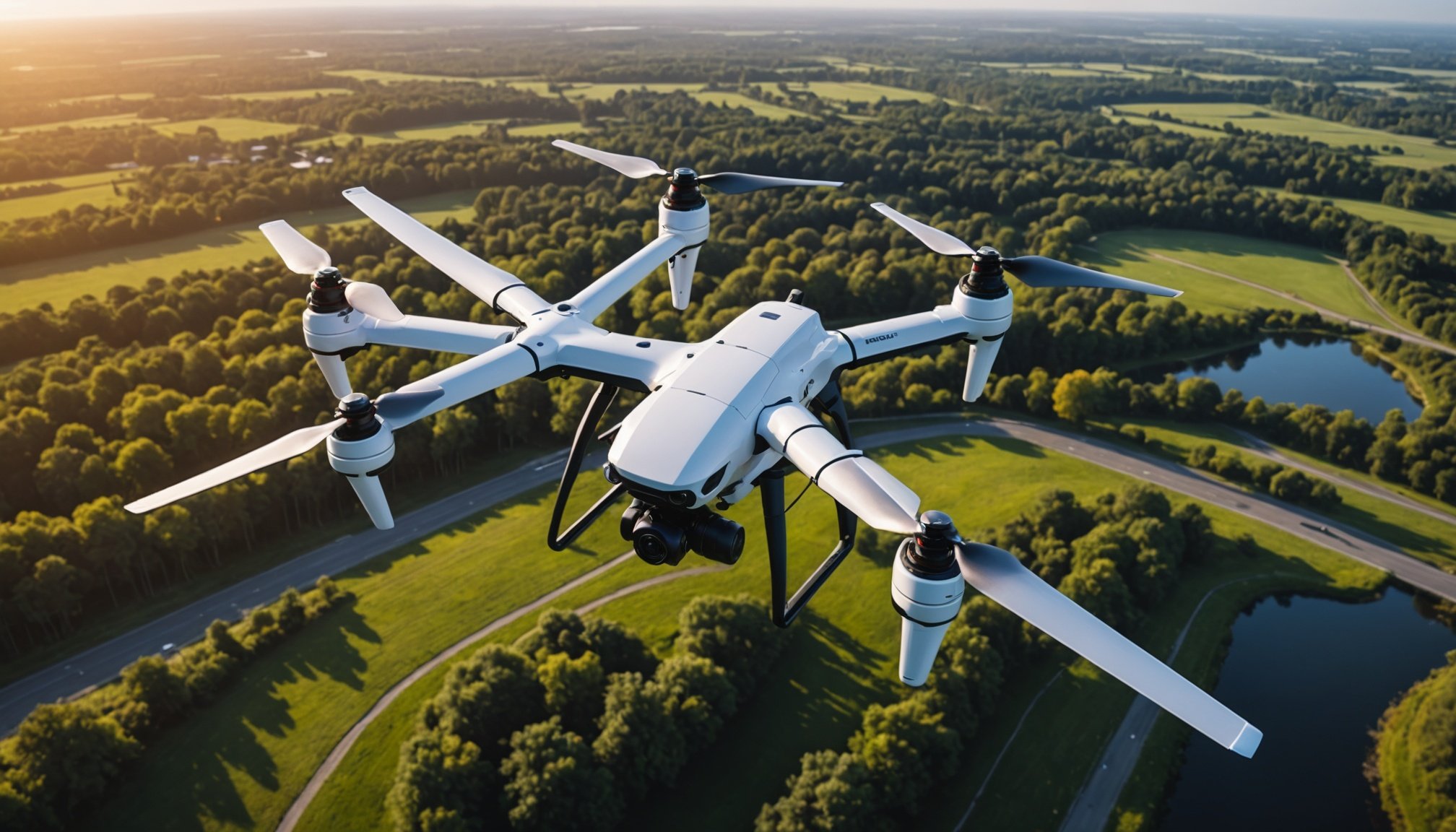Overview of AI in Autonomous Drone Navigation
In recent years, the integration of AI technologies into autonomous drone navigation has revolutionized the industry. The deployment of autonomous systems in drone navigation has led to significant advancements, expanding the capabilities of drones beyond conventional uses. AI technologies enable intricate navigation, obstacle avoidance, and precise delivery systems, setting new standards in both commercial and recreational applications.
As drone navigation evolves, the trends point towards increased adoption of AI to enhance efficiency and safety. The current state of technology in autonomous drones sees them equipped with sophisticated sensors and algorithms. These AI-driven systems allow drones to interpret and react to real-time data, promoting seamless operations in complex environments. For instance, drones can now autonomously map out optimal flight paths and adjust to dynamic conditions, reducing the likelihood of accidents.
In parallel : Essential Factors to Consider for Building a Scalable and Secure Data Lake
The key benefits of integrating AI in navigation systems are numerous. Firstly, there is enhanced operational efficiency, as drones can perform tasks with minimal human intervention. Secondly, AI equips drones with better decision-making capabilities, crucial for applications such as search and rescue missions or agricultural monitoring. Ultimately, AI technologies anchor the future of drone navigation, promising innovative solutions and greater reliability in various sectors.
Sensor Integration Considerations
When considering sensor technologies for autonomous drones, the variety of sensors used plays a crucial role. These sensors typically include visual cameras, LiDAR, GPS, infrared, and ultrasonic sensors. Each has unique advantages that contribute to a drone’s ability to navigate its environment. For instance, visual cameras are vital for capturing images, while LiDAR provides depth perception necessary for obstacle avoidance.
In parallel : Top Strategies for Effectively Managing AI Model Training in Distributed Environments
Data fusion is a complex task that combines different sensor inputs to give a coherent understanding of the drone’s surroundings. One challenge of data fusion is aligning data with varying update rates and resolutions. This can lead to inaccuracies in real-time applications if not managed correctly. Therefore, calibrating and synchronizing sensor data is paramount for achieving accurate navigation.
To successfully incorporate sensors into drones, follow best practices that involve:
- Selecting sensors based on the drone’s specific mission and environmental conditions.
- Ensuring compatibility with the drone’s system architecture.
- Testing sensor accuracy and reliability in various conditions.
Effective environmental sensing is achieved by merging all available sensor data, allowing the drone to make informed navigation decisions even in dynamic or uncertain environments. Proper integration ensures that drones can adapt to changing situations and maintain optimal performance.
Machine Learning Algorithms
In the realm of drone navigation, machine learning algorithms play a critical role in optimising the navigational capabilities and ensuring smooth operations. These algorithms are integral in the transformation towards automated drones capable of intelligent decision-making through the analysis of real-time data.
Popular machine learning algorithms often employed include reinforcement learning, which allows drones to learn optimal navigation paths by rewarding positive outcomes and penalizing negative ones. Another notable algorithm is supervised learning, where drones are trained on diverse datasets to predict the best possible routes in various environments.
Real-time data processing is crucial for the efficacy of these algorithms. It facilitates swift reaction to environmental changes, thereby ensuring safer and more reliable drone operations. By continuously analysing incoming data, drones can dynamically adjust their pathways, avoid obstacles, and optimize their routes for efficiency.
Several case studies highlight successful applications of these machine learning techniques in drones. For instance, a recent project utilized deep learning algorithms to enable drones to autonomously identify and track objects, improving surveillance capabilities. Similarly, another study implemented a machine learning framework enabling drones to accurately deliver packages, showcasing significant advances in predictive analytics within this field. Through these innovations, drone technology continues to push boundaries, fostering new opportunities across various sectors.
Ethical Considerations
Autonomous decision-making in drones raises numerous ethical concerns, primarily revolving around accountability. When a drone operates on its own, the question of who should be held responsible for its actions becomes complex. AI responsibility must be addressed to ensure that when autonomous systems make decisions, there is a clear line of accountability. This necessitates robust frameworks that define who is answerable when these systems fail or cause harm.
Moreover, the societal impact of drones cannot be overlooked. Transparency in AI algorithms is essential. People need to understand how these algorithms work to foster trust and ensure they are being used ethically. This transparency also aids in the critical examination of how decisions made by drones affect society at large. For instance, drones used in surveillance must balance technological advancement with societal safety and privacy.
Striking a balance between technology and ethical practices is crucial. As drone technology evolves, it is vital to integrate ethical discussions into the development process. Only by prioritising these considerations can the deployment and use of drones truly benefit society without compromising safety and trust.
Regulatory Compliance
Navigating the expansive maze of aviation standards can be daunting for drone operators. With ever-evolving regulations, staying compliant is not just advisable—it’s crucial for both safety and operational success. Current regulations primarily focus on maintaining airspace safety and managing the capabilities of drones in civilian environments. Recognizing these regulations is essential to prevent legal complications and ensure proper integration into the airspace.
Why is compliance so important? In essence, non-compliance can lead to fines, grounding of operations, or even accidents. Therefore, understanding the unique aviation standards set by respective local authorities is necessary to avoid any potential hazards.
To effectively navigate through this regulatory landscape, drone operators can employ various strategies:
- Stay updated: Constantly monitor changes in regulations and aviation standards, especially with the frequent updates from local to international bodies such as the FAA or EASA.
- Engage in training: Pursuing regular training sessions ensures that operators are informed of and adhere to critical compliance requirements.
- Collaborate with experts: Partnering with legal and operational experts specialized in drone compliance can provide invaluable insights and support.
Ultimately, a proactive approach towards understanding and adhering to regulations is pivotal for safe and efficient drone operation.
Environmental Impacts
As the world embraces drone technology, it’s crucial to address environmental concerns associated with their operations. Drones, like any mechanical device, leave a footprint on the environment. This footprint encompasses aspects like energy consumption, noise pollution, and electronic waste. Understanding this impact is the first step to mitigating it through an effective impact assessment.
Evaluating the environmental footprint involves examining the entire lifecycle of a drone, from production to disposal. Materials used in manufacturing, battery types, and energy efficiency contribute significantly to their overall impact. Adopting more sustainable practices in building and powering drones is essential. This includes utilizing eco-friendly materials, improving battery life, and employing renewable energy sources wherever possible.
AI navigation development plays a pivotal role in shaping drone sustainability. Enhanced autonomous systems can reduce energy consumption by creating optimal flight paths and conserving resources. Future trends are leaning towards even more innovative approaches to minimize ecological impacts. This can include integrating solar power capabilities and developing biodegradable materials for drone construction.
By prioritizing sustainability in these areas, we can mitigate the environmental concerns associated with drone technology and ensure these innovations contribute positively to our planet’s future. As technology advances, ongoing research and impact assessments will prove vital in discovering new ways to reduce the ecological footprint of drones.
Practical Insights and Expert Opinions
In the realm of AI integration, several real-world challenges persist, as experts in the field diligently explore solutions. One of the most significant obstacles involves ensuring seamless communication between artificial intelligence systems and existing technological infrastructure. Industry insights highlight the importance of adopting adaptable frameworks that accommodate technological innovations, facilitating smoother transitions and enhanced operational efficiency.
Expert analysis suggests that maintaining robust data security is paramount. As AI systems become more sophisticated, they collect and analyse vast amounts of data. Implementing stringent security protocols safeguards this information against potential breaches, maintaining user trust. Furthermore, experts recommend adopting best practices like regular system updates and comprehensive training for all personnel involved in AI deployment to ensure optimal system performance.
In discussing the future of autonomous drone navigation systems, innovations such as advanced sensor technology and enhanced machine learning algorithms represent a leap forward. These innovations promise to refine navigation accuracy and decision-making capabilities, driving the evolution of drone technology. Real-time data processing and adaptive learning models are set to redefine operational standards, paving the way for more efficient and reliable autonomous systems.
Stay tuned to industry insights and recommendations as the landscape of AI and autonomous technology continues to evolve, promising exciting developments and solutions to today’s challenges.











